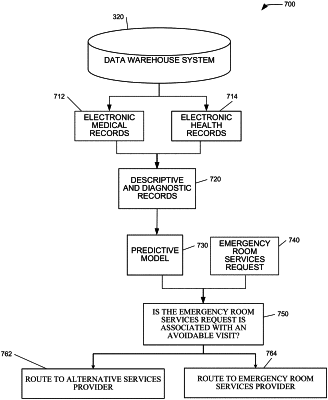| CPC G16H 40/20 (2018.01) [G06F 16/254 (2019.01); G06N 20/00 (2019.01); G06Q 40/08 (2013.01); G16H 10/60 (2018.01); G16H 50/20 (2018.01); G16H 50/70 (2018.01); G16H 50/80 (2018.01); G16H 70/20 (2018.01)] | 18 Claims |

|
1. A method for providing prediction based healthcare recommendations, the method comprising:
in response to receiving an emergency room services request from a client device associated with a patient,
creating a predictive analytics model configured to provide a score indicating a likelihood that the emergency room services request is associated with an avoidable visit, the emergency room services request including a requestor location, a requestor identifier, and requestor symptoms;
training the one or more predictive models using first data collected from health records over a first time period, to create trained models;
validating the trained models using second data collected from the health records over a second time period, to create validated models, the first time period comprising a duration longer than the second time period, and the first time period comprising an age older than the second time period;
determining that supplemental information is needed to predict whether an emergency room visit is avoidable, using the predictive analytics model; and
in response to supplemental information being needed,
transmitting a prompt to the client device associated with a patient, the prompt including a supplemental question;
receiving a response to the supplemental question, from the client device;
designating the response as a feature;
weighting the feature with an associated weight;
applying the predictive analytics model to the feature with the associated weight to score the likelihood that the emergency room visit is avoidable and create a scored likelihood;
generating a prediction based on the predictive analytics model and the scored likelihood; and
routing a request to an alternative services provider or an emergency room services provider, based on the prediction.
|